U.S.A. –-(AmmoLand.com)- If you’ve never heard of Area 419, I really don’t know what you’re doing with your life. But, for those that haven’t Area 419 has been making some of the best precision rifle builds, reloading equipment, and a slew of really innovative accessories primarily tailored to the PRS or long-range rifle shooter. What I really like about their products is you can tell that they are shooters, and address real issues that shooters have. They don’t randomly throw a bunch of crap out and hope something sticks. Everything is calculated, engineered, and executed with extreme precision and attention to detail. Recently they launched their first suppressor, the Maverick.
Area 419 Maverick and the Hellfire System

What sets the Area 419 Maverick apart from the ever-growing number of suppressors on the market? Well, for starters you get six different configurations or ways to use the suppressor for one tax stamp. You’ll get everything from an ultra-compact suppressor that’s just enough to take the edge off for hunting, all the way up to a very quiet long suppressor, and some interesting options in the middle that include a muzzle brake for the ultimate in recoil reduction while still giving you some sound suppression.
This is a very impressive package and offering. While it does probably cater more to the precision rifle guy, the Maverick as a package has configurations that will work great for the hunter, or the guy who just wants a really quiet suppressor all in one package and most importantly with one tax stamp. In addition, it works with the Area 419 Hellfire mounting system. This system is one of the most impressive mounting systems available today. I get to shoot a lot of cans, and a lot of different mounting systems, and I’ll be honest, typically I stick with the Dead Air Keymo and the Q cherry bomb. But after trying out the Hellfire system, I’ll be using it on all my long-range rifles for sure.
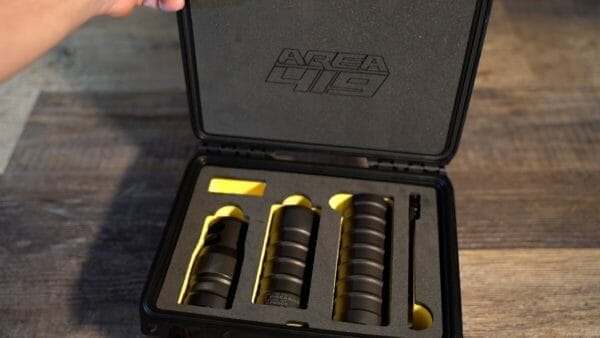
Muzzle brakes are atrociously loud, there’s nothing I hate more than when I’m shooting suppressed and a guy shows up at the range with some absolutely vicious muzzle brake. Not only are they loud, but they also give the shooter a concussive blast every time they fire the rifle. That blast, along with being irritating, can also be bad for the shooter if there is enough exposure. On the positive side, muzzle brakes kill the recoil and allow the shooter to greatly control the muzzle of the weapon, allowing for quick follow up shots. Suppressors also reduce recoil, not as much as brakes, but they do reduce it. They also turn their recoil impulse into more of an elongated push, rather than one quick sharp blast. This recoil impulse isn’t usually desired by competition shooters because they can’t get follow up shots off quite as quickly. Suppressors also make shooting much more enjoyable by lowering the sound signature from the gunshot and eliminating the concussive blast coming off the rifle. The Area 419 Maverick is very unique because it has a couple of configurations where you’ll get very impressive, noticeable, and drastic recoil reduction; very similar to that of one of Area 419’s muzzle brakes, while getting some noticeable sound reduction. It’s like the best of both worlds.
When you get the Maverick, it comes in this really nice case with the modules all laid out inside. You’ll immediately notice something about Area 419 products; the very evident attention to detail. From the little things like the bi-color foam in the case to the absolutely exquisite machining in all the parts. The whole presentation radiates quality that is sometimes lost in a simple picture that you may have seen in passing on the internet. The middle section is the part that is actually going to attach to your rifle, and the hellfire mounting system. This is also the serialized part and referred to as the core. To the right of that, you’ll have the suppression module, or stage 2. To get any serious sound reduction you’ll have to use one of the setups that include this module. On the left, you’ll have the muzzle brake and one additional expansion chamber that can be used to achieve a little extra expansion of the gasses; this is referred to as stage 1.
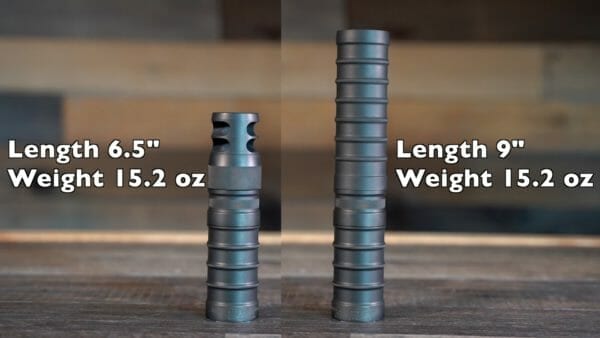
The Maverick is 1.72 inches wide, can range in length from 4 inches, all the way up to 9 inches long, and weigh from 7.3 ounces up to 15.2 ounces. The majority of the can is constructed of titanium to maintain the extremely lightweight in relation to size. The exception is the brake. It is made out of stainless steel. The brake is stainless steel to give the core and stage 1 the same weight as the full-length configuration. Meaning, that you should have virtually no point of impact shift between these two configurations. There are a lot of pieces, and they all mate together with tapers allowing perfect alignment every time. Everything is a left-hand thread so that you won’t loosen the muzzle device from your barrel when removing, and everything is PVD coated. Again, I just have to say that the attention to detail in the machining is just superb, the way everything threads together so perfectly. I know that may sound insane, but you just need to handle one of these to really appreciate it.
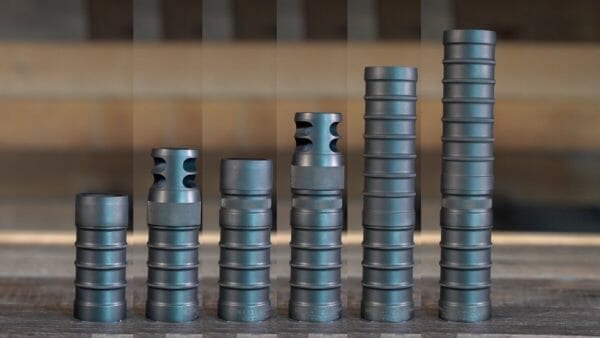
Like I mentioned, there are 6 configurations for the Maverick, the first one is really small and consists of only the core with nothing else. You can shoot it like this, and it will give you some very minimal suppression of sound and blast, but not much more than that. If you add the muzzle brake from stage 1, to this module, it will give you excellent recoil management and muzzle control, some blast mitigation, and sound will essentially go back to almost having no suppressor at all. Here’s where things get interesting. If you take the core and add the expansion module from stage 1, that chamber really makes a notable difference to sound performance. This would perform about as well as most “K” cans on the market. It takes the edge off a good bit, but probably not hearing safe on most rifles. However, if you are l a hunter and want a very small and light package to walk through the woods, while still giving you some suppression, this is a great option. It is only 5 inches long and weighs in at only 9.1 ounces.
If you add the brake to this setup, you now have the core and both parts from stage 1; you have what I think is one of the most practical setups for the maverick. This is how I see many people using this for PRS or other competition uses. This orientation gives you some suppression, while also giving you great recoil reduction and muzzle control. As you thread the brake on, you’ll notice that it moves freely so that you can control the alignment. The brake itself will also have a line to show level. When you get it orientated as you want it, just push on the tip and the massive surface area on the taper should hold it in place as you tighten the lock collar. This system gives you perfect orientation and alignment of the brake, no matter how the suppressor is orientated.

In my opinion, this setup comes close to hearing safe, depending on the rifle it is used on. For instance, we shot it on a 26 inch 6.5 Creedmoor, and it felt very comfortable. However, move down to an 18 Inch 6.5 Creedmoor and it probably crept above that threshold. Also, just want to say I hate the term “hearing safe”. You should go check out pew science for an in-depth look at what hearing safe really is, and it basically comes down to exposure and the number of shots fired. But anyway, I’m just trying to give you a relative idea; you probably wouldn’t want to fire this configuration all day without some type of hearing protection.
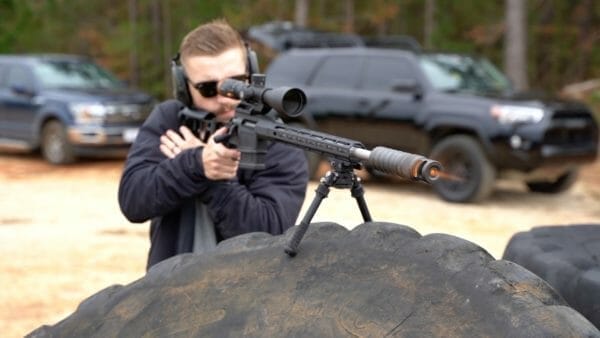
For the next configuration, take the core and remove stage 1, then screw on stage 2, or as I like to call it the suppression module. This is where things start to get really quiet. In this setup, it is very comfortable to shoot on any platform we tried it on and this is my other favorite configuration for the maverick. The final configuration is taking the core, the expansion chamber from stage 1 and then stage 2. This is the largest and quietest configuration of the Maverick. In this configuration, the Maverick is a very quiet suppressor, comparable to many top-performing suppressors available.
As impressive as the Maverick suppression system is, the Hellfire Brake and mounting system is equally impressive. The first thing you do is install this small universal adapter on to the threads of your rifle. The end of the adapter has flats that will fit into a 5/8 wrench or socket. Notice that the universal adapters mating surface is at a taper to better help align and hold concentricity with anything you attach to it. Along with providing alignment, the taper seal will also keep the threads clean for attaching either the muzzle brake or the suppressor.
To attach a Hellfire brake, just start threading on the brake; they are left-hand threads, so that on most rifles when you’re removing the brake or suppressor from the universal adapter it is opposite the rifle threads. Meaning the adapter will never come off, and end up caught in the suppressor. Opposing thread patterns are always a very good idea when it comes to suppressor attachment. As you thread the brake on you’ll notice that it moves free, so that you can control the orientation. The brake itself will also have a line to show level, and a dot to show the top of the suppressor. When you get it orientated as you want it, just push on the tip and the massive surface area on the taper should hold it in place as you tighten the lock collar. This system gives you perfect orientation and alignment of your muzzle device with no shims that can cause stacking and poor alignment. This is pure genius. When you want to install a suppressor, just loosen the locking collar remove the brake, and screw on the suppressor. Just remember in this case, it’s lefty tighty, and righty loosey.
Now here are some more cool things about the Hellfire mounting system.
All you guys out there, with odd thread patterns who cry because whatever massive suppressor company won’t make your thread pitch, Area 419 probably makes it, and yes that includes 18×1 for all you Steyr guys I talk to. Think the Hellfire system is really cool, but not sure you need another suppressor? Area 419 makes an adapter that fits into the back of the standard rear thread 1 3/8 x 24. That’s going to cover a whole ton of cans from the Silencerco Hybrid, Rex Silentium cans, and the Dead Air Nomad series.
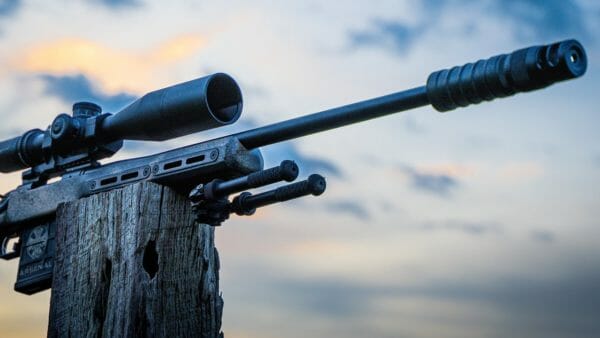
Being a Suppressor constructed of titanium, there are of course some limitations that come with the weight savings on the Maverick. Basically, you can use it on 556 rifles with 16 inch barrels or greater, 308 barrels 20 inches or greater, then according to Area 419, it’s also any other short-action cartridge with barrels over 22 inches. I think those guidelines are staying on the extreme safe side; we did use it rather extensively on an 18 inch 6.5 Creedmoor and everything seemed perfectly fine. However, it is safe to say that you wouldn’t want to do anything too stupid with the Maverick; no short barrel 556s, and no long action calibers like 300 Win mag or 300 PRC.
Area 419 has done some amazing things with the Maverick, and while it may not be for everyone, the people that it is built for will greatly appreciate this offering that covers so many bases in one nice neat concise package. I personally really like the recoil management and the suppression of the Maverick in the longer configuration with the brake, and you know I’m a fan of either of the configurations with the suppression module. In the long configuration, the Maverick is very quiet, maybe not quite as quiet as some of the quietest cans we’ve tested, but I will say it’s quieter than the majority of cans available. I think anyone would be very impressed with the suppression in either of the longer configurations. It is rather extraordinary that Area 419 has given you so many configurations that cover so many bases in one offering with one tax stamp. You can put the muzzle brake on it and take it out for a PRS match or some long-range shooting. You can make it nice and compact for a hunting trip, or you can make it really long and really quiet to impress your friends for a weekend trip to the range.
About Alabama Arsenal
We conduct in-depth, unbiased reviews on firearms and accessories. We are made up of all different backgrounds to give you the best range of opinions, including military experience and gunsmith work. Be sure to check out our Facebook and Instagram.
Unlike many channels out there, we make it a priority to respond to your comments. We enjoy engaging with our followers and will gladly answer any reasonable questions you may have.

